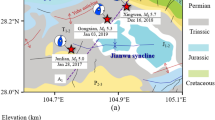Abstract
On October 6, 2000, the 2000 Western Tottori Earthquake (Mjma 7.3) occurred in the western Tottori prefecture area, southwestern Japan. It initiated at a depth of 12 km at the bottom of the seismogenic zone, which was derived from aftershock distribution. The aftershocks extend over a 35 km length in a north-northwest direction. Spatial and temporal distribution of the aftershocks exhibits local characteristics in the fault region. The northern part consists of earthquake clusters while the southern part consists of a rather simple lineament of aftershocks, and the spreading and decaying rate of the aftershocks is slower in the northern part. This contrast is possibly due to the heterogeneity of the fault system and probably affected the rupture process of the mainshock. Two swarm sequences occurred in the surrounding region after the mainshock. One initiated 48 hours after the mainshock 25 km southwest of the main aftershock distribution. The other started 20 hours after the mainshock northeast of the mainshock on the southeast flank of Daisen volcano. These activities are probably induced seismicity due to stress changes in the focal region. Pre-seismic swarm activities occurred in the focal region from 1989 and deep low-frequency earthquakes were observed since 1999. It is important to understand the relationship between these possible precursory phenomena and the occurrence of the mainshock.
Similar content being viewed by others
References
Active Fault Research Group, Active Faults in Japan (New edition), Tokyo Univ. Press, 437 pp., 1991.
Hasegawa, A. and A. Yamamoto, Deep, low-frequency microearthquakes in or around seismic low-velocity zones beneath active volcanoes in northeastern Japan, Tectonophys., 233, 233–252, 1994.
Hasegawa, A., N. Umino, and S. Hori, Seismic activity and heterogeneity of the crust in the Nagamachi-Rifu fault zone, Monthly Chikyu, 263, 313–320, 2001.
Hirata, N., S. Ohmi, S. Sakai, K. Katsumata, S. Matsumoto, T. Takanami, A. Yamamoto, T. Iidaka, T. Urabe, M. Sekine, T. Ooida, F. Yamazaki, H. Katao, Y. Umeda, M. Nakamura, N. Seto, T. Matsushima, H. Shimizu, and Japanese University Group of the Urgent Joint Observation for the 1995 Hyogo-ken Nanbu Earthquake, Urgent joint observation of aftershocks of the 1995 Hyogo-ken Nanbu earthquake, J. Phys. Earth, 44, 317–328, 1996.
Hurukawa, N. and S. Ohmi, A hypocenter-determination method using station corrections as a function of hypocenter coordinates, J. Seismol. Soc. Jpn., Ser. 2, 46, 285–295, 1993.
Irikura, K. and M. Ando, Learning from the 1995 Hyogo-ken Nanbu Earthquake, J. Phys. Earth, 44, i–v, 1996.
Ito, K. and A. Kuroiso, Detailed spatial distributions of foreshock and aftershock activities of small earthquakes, J. Seismol. Soc. Jpn., Ser. 2, 32, 317–327, 1979.
Iwata, T. and H. Sekiguchi, Source model of the 2000 Tottori-ken Seibu earthquake and near-source strong ground motion, Submitted to 11th Japan Earthq. Eng. Symposium, 2002.
Katao, H., Activation of seismicity in the northern Kinki district, Reports of the Coordinating Committee for Earthquake Prediction, 54, 517–521, 1995.
Katao, H. and Y. Iio, Abnormal initial rise of the foreshock of the 1995 Southern Hyogo Prefecture earthquake, Reports of the Coordinating Committee for Earthquake Prediction, 54, 620–623, 1995.
Kishimoto, Y., K. Oike, K. Watanabe, T. Tsukuda, N. Hirano, and S. Nakao, On the telemeter observation system of the Tottori and the Hokuriku micro-earthquake observatory, J. Seismol. Soc. Jpn., Ser. 2, 31, 265–274, 1978.
Mogi, K., Seismic activity before and after the 1995 Hyogoken-Nanbu Earthquake, Reports of the Coordinating Committee for Earthquake Prediction, 54, 557–567, 1995.
Nakamura, M. and M. Ando, Aftershock distribution of the January 17, 1995 Hyogo-ken Nanbu Earthquake determined by the JHD method, J. Phys. Earth, 44, 329–335, 1996.
Ohmi, S., Data processing of the urgent joint observation of aftershocks of the 1995 Hyogo-ken Nanbu earthquake, Programme and abstracts, The seismological society of Japan, No. 2, A39, 1995.
Ohmi, S., Aftershock distribution of the 2000 Western Tottori Earthquake by use of the station corrections as a function of hypocenter coordinates, J. Seismol. Soc. Jpn., Ser. 2, 54, 575–580, 2002.
Ohmi, S. and K. Obara, Deep Low-Frequency Earthquakes beneath the Focal Region of the Mw 6.7 2000 Western Tottori Earthquake, Geophys. Res. Lett., 2002 (in press).
Ohmi, S., K. Watanabe, N. Hirano, A. Nakagawa, F. Takeuchi, H. Katao, H. Takeuchi, T. Asada, M. Koizumi, K. Ito, H. Wada, T. Shibutani, S. Nakao, K. Matsumura, T. Konomi, K. Kondo, and H. Watanabe, SATARN system, a unified microseismic observation network in D.P.R.I. Kyoto University, Annuals of Disas. Prev. Res. Inst., Kyoto Univ., No. 42 B-1, 45–60, 1999.
Sekiguchi, H., T. Iwata, Y. Sugiyama, Y. Fusejima, and H. Horikawa, Faulting process and condition for its occurrence of 2000 Tottori-ken Seibu Earthquake, Abstracts, 2001 Japan Earth and Planetary Science Joint Meeting, S3-006, 2001.
Ukawa, M. and K. Obara, Low frequency earthquakes around Moho beneath the volcanic front in the Kanto district, central Japan, Bull. Volcanol. Soc. Jpn., 38, 187–197, 1993.
Ukawa, M. and M. Ohtake, A monochromatic earthquake suggesting deep-seated magmatic activity beneath the Izu-Ooshima volcano, Japan, J. Geophys. Res., 92, 12649–12663, 1987.
Umeda, Y., K. Matsumura, T. Shibutani, S. Ohmi, and H. Katao, The 2000 Western Tottori Earthquake—precursory swarm earthquake, main shock and aftershock—, J. Natural Disaster Science, 19-4, 501–512, 2001.
Wessel, P. and W. H. F. Smith, New, improved version of the Generic Mapping Tools released, EOS Trans. AGU, 79, 579, 1998.
Author information
Authors and Affiliations
Corresponding author
Rights and permissions
About this article
Cite this article
Ohmi, S., Watanabe, K., Shibutani, T. et al. The 2000 Western Tottori Earthquake—Seismic activity revealed by the regional seismic networks—. Earth Planet Sp 54, 819–830 (2002). https://doi.org/10.1186/BF03352075
Received:
Revised:
Accepted:
Published:
Issue Date:
DOI: https://doi.org/10.1186/BF03352075




